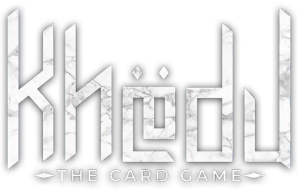
Rules v2.8
Overview
Feint among the blowing sands of the desert, faceless voices sing a dissonance. With each hymn, the tides of an ageless war eb. The value of honor remains true among the shifting sands of Khedu though. Testaments to the significance of honor in the eyes of the Wills are the Khana: Great beasts and legacies of valiant heroes that roam the wastes.
An attempt to end such a war is to fight the wind.
But to become a living memory, to become Khana by gaining Honor and leaving a Legacy: these feats are worth pursuit. To Lead and influence champions and their battles, to dance with the symphonies of the desert dissonance, to sing with the sands. These feats are qorth pursuit.
Play your influence as an instrument and match the cadences of the Khedu desert. Lead champions, sway the minds of those who traverse the dunes, and create ballads of combat. Play your influence until it runs out, and when your song ends, let us see how played loudest.
Skillfully leverage combinations of Units, the Desert, Cadences, Ballads and dice to craft dynamic combat scenarios and shape their outcomes.
The ultimate objective is to use your Influence and Honor to create as much of a Legacy as possible. The player with the most legacy at the end of the game wins.
The game concludes when all players have used up their their influence.
Objective
In Khedu, your victory is based on the amount of Legacy you have. Legacy can be earned by completing achievements, winning combat encounters, or making strategic moves. Legacy can be spent to activate various cards and abilities, but doing so may risk your standing. Balancing the cost of actions against their potential rewards is important. Legacy is represented in two ways: Honor Tokens indicate a unit’s augmented value in play, and Legacy Points – which is tracked by a designated scorekeeper.
Legacy points
Each player’s score is represented with Legacy points and should be kept track on a notepad or a scorekeeping app. At the end of each player’s turn, a designated scorekeeper should annotate the number of points a player gains or spends.
Game Components - Cards
Three decks are used in Khedu. The Resources Deck, Cadences Deck and Desert Stacks. The Resources Deck is comprised of unit cards and spell cards, this deck is the primary deck used during the game. The Desert Stacks are a comprised of Unit cards and acts as a shared resource area that each player can manipulate during their turn. The Cadences deck is comprised only of special spells that can be used to augment combat scenarios.
Resource Deck

78 cards
5 copies of 12 units & 3 copies of 6 cadence Spells.
Desert Stacks
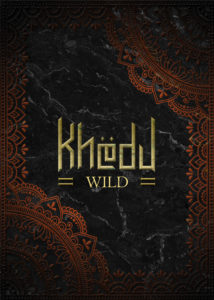
36 cards
4 Identical stacks of 18 unique units. Each stack is refered to as a Desert Stack.
Cadences Deck

16 Cards
4 copies of 4 unique Cadence Cards. These 16 cards make up the Cadences Deck.
Unit Cards
Units cards can be found in both the Resource Deck and the Desert Stacks. Combat between unit cards is initiated my players, manipulated by Cadences and Commands and resolved with a dice roll.
Unit Card Attributes
Discard Activation Cost
The top-left (cards) icon represents the number of cards to discard from your hand to activate the unit as an aggressor in a conflict.
Attack Dice Quantity
The Bottom-Left (Dice) icon represents the number of dice that you roll to conduct an attack. Roll the number of attack dice after the activation cost has been paid.
Defense Value
The Top-Right (Shield) icon on each unit card represents its defense value. If an attacking unit rolls equal to or greater than this number, this unit is defeated.
Reward Value
There are one to four markers on bottom right of each unit card annotated with an RV icon. The number of lines represents the number of Legacy Points or Honor Tokens awarded for defeating this card.
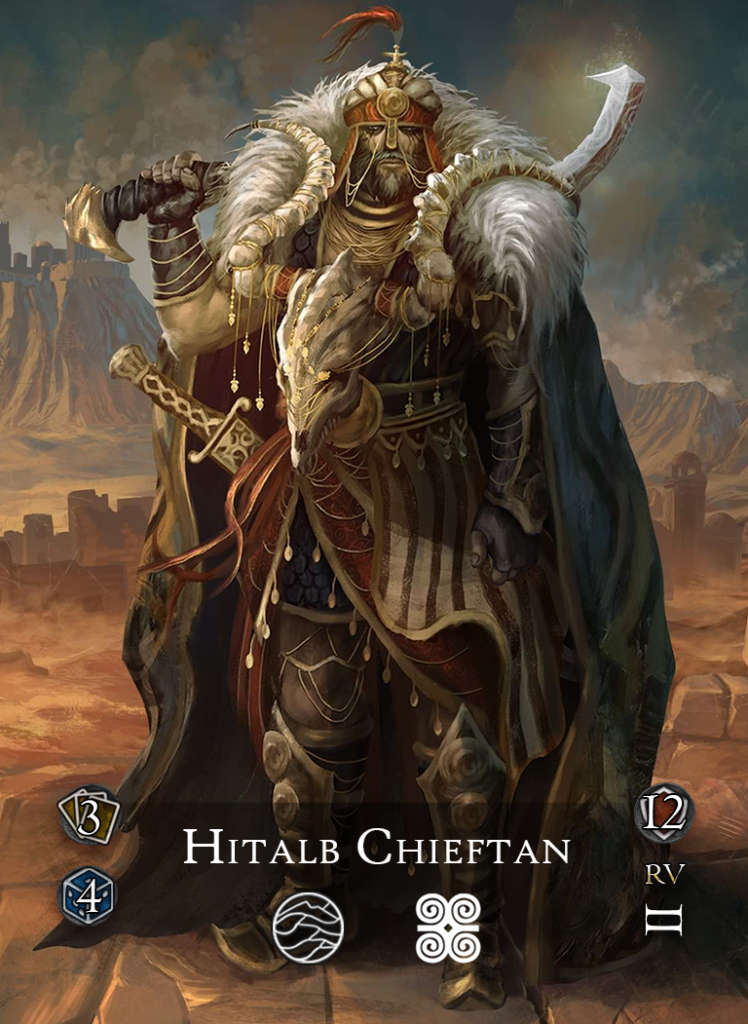
Spell Cards
There are two types of spell cards: Commands and War Cadences

Commands
Commands influence the placement and efficiency of unit cards. Throughout the game, you’ll draw Commands from the Resources Deck. From there, they can be played during your turn. To play a Command, you must pay for it with LP. Any number of Commands can be played during your turn and in any order. When Commands are paid for, annotate the payment wherever LP are being tracked.
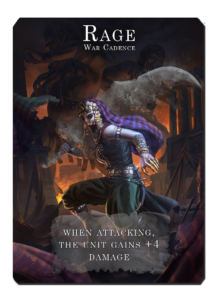
Cadences
War Cadences are abilities that influence the sands of Khedu. A War Cadence can modify the attacking unit before the combat roll. Some effects are permanent, and some are temporary. These can be converted into upgrades called “Eternal Cadences” and act as permanent combat modifiers for Unit Cards.
Game Components - Pieces
Influence Tokens
Influence is a currency that allows you unconditionally control units in Khedu. Spend Influence to deploy units from your hand into your hero slot. Once an Influence token is used, it can only be generated from achievement rewards.

Honor Tokens
When a unit card is destroyed it will yield a reward, which can be taken as Legacy points or as Honor Tokens. Honor tokens can be placed on player controlled units to unlock abilities and bonuses. Honor tokens placed on desert units increases their RV.

Clan Boards (Digital Only)
The Clan Boards offer insight into the history and characteristics of each clan, as well as an inventory of the cards associated with that clan, unique first turn bonuses, and a catalog of the clan’s achievements. In addition to these clan-specific features, the boards also provide a record of the game’s general achievements.
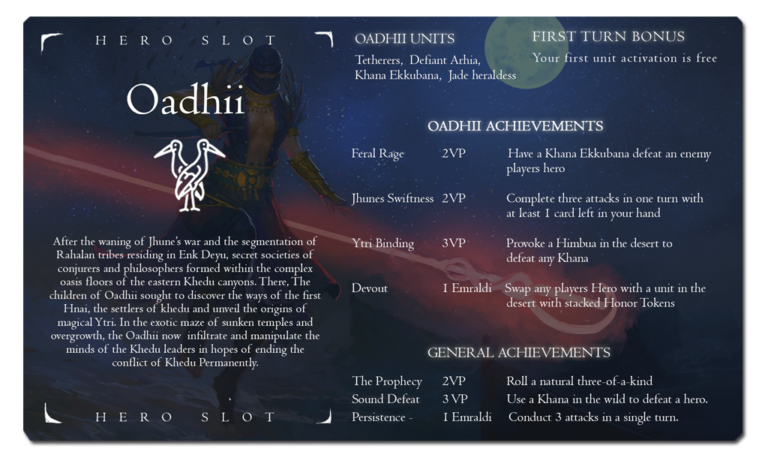
Dice
6 dice are included in the box. Roll the attack dice number of an aggressor unit and compare the sum of the dice rolled against the defense value of a defending unit to resolve combat.
Game Areas
Cadre
The Cadre is a player controlled card arrangement made up of two card slots. For a player to earn Honor Tokens or LP, they must complete combat configurations that resolve in favor of a unit in their Cadre. Placing a unit in the Cadre from a player’s hand costs 1 Influence Token. Only the Units listed in your Clan Board can be placed in your Cadre and Only 1 unit may be placed into the Cadre per turn unless otherwise specified. Up to 2 cards may reside in the Cadre at a time, each must be in their own slot.
Opposing players and units in the desert may only attack units in the front row of the cadre unless otherwise specified. Attacks outbound may leverage any card in the Cadre.
Enseble
The Ensemble is a player controlled, card arrangement that contains Cadence cards side-by-side. The Ensemble may play a maximum of 4 Cadences at a time unless otherwise specified. Active Cadences are shown face up, inactive Cadences are kept face down.
The Desert
The desert is composed of Desert Stacks equal to the number of players in the center of the play area, 2 rows and 2 columns (4 decks). Units in each stack should be organized in ascending order by defensive rating. Desert Stacks are placed face up. The card exposed should have a defense rating of (9 or 10), and the card on the bottom should be (17 or 18).
The Desert may be manipulated by any player during their turn by influencing units in the Desert to attack in any direction. Units in the desert may be provoked into attacking units of your choosing or targeted as defending units. When destroyed, units in the desert go face up to the bottom of their stack. Units in the desert may be provoked to attack any exposed unit card, even units in your Cadre.
Units in the desert that are victorious in a combat scenario receive Honor tokens equal to the reward value of the unit they were victorious over.
For example, if a Himbua (RV of 2) in your Cadre unsuccessfully attacks a Khana Ubak (RV of 3 ) in the desert. The Khana Ubak in this scenario receives 2 Honor tokens stacked on it and is now worth 5 Honor.
Various Command Cards can influence the placement of Units in the Desert
Gameplay Prep
The game box contains all the components required to play the Version 1 game with the exception of point tracking. To play the 2.8 version of the game, use the clan boards available in the Clan Board section of this rulebook. The Box Contains the following:
- 45 Player Deck cards (5 copies of 6 units, 5 copies of 3 Commands)
- 36 desert cards (4 stacks of 9 cards)
- 16 War Cadence cards (4 copies of 4 cards)
- 16 Legacy tokens
- 32 Honor tokens
- 6 dice

Game Setup
To setup a game of Khedu, follow these steps in order.
- Each player rolls a die to determine who goes first. In the event of a tie for the highest roll, players roll again.
- Shuffle the Resources deck. Deal 5 Resource Cards to each player in order. Then place the deck face down within reach of all players or a dealer.
- If any player is dealt only spell cards, they may show all of their cards, draw 5 new cards, then shuffle their old cards back into the deck.
- Shuffle the Cadence deck. Deal 5 War Cadence cards to each player in order.
- Place a number of desert stacks equal to the number of players face-up in the center of the play area.
- Give each player 3 Influence tokens.
- Each player picks an online clan board they wish to use for their game, clan boards are picked one after another, no two players may use the same clan board.
- Once all players have their clan boards chosen, the first player may begin their turn.
First Turn Bonus
At the start of the game, each player is dealt 5 cadence cards. Each player will place one card into their Ensemble face up and discard one. The other 3 remaining cadence cards are kept face down in each players Ensemble.
Turns
Player Turn Overview
Each turn starts with a player replenishing their hand back to 5 cards in total if they have less than 5 cards . The player may also take rewards from any Clan Board enabled turn bonuses. Then, the active player chooses to take an Action turn, or a Meditation turn, or Pass. If a player took a Meditation turn during their last turn, they may not take a Meditation turn again this turn.
Players may choose to skip their turn at the cost of 3 VP if they have a unit in their Cadre. Players who wish to skip their turn without a hero present must pay 5 VP. They cannot pass their turn if they don’t have the VP.
Action Turn
During an Action turn, the player may take any of the following actions:
- Placing 1 unit card into their Cadre at the cost of 1 Influence Token.
- Building any number of combat scenarios.
- Playing any number of Command cards to manipulate card arrangement
A player’s Action Turn ends when they have completed any of these actions or have no more cards in their hand that they wish to play.
Meditation Turns
Instead of taking an Action turn a player may take a turn where they replenish or enhance their resources. This type of turn is called a Meditation. During a meditation a player may perform at least one of the following actions no more than one time.
- Replenish any of their 4 used Cadences by drawing from the top of the Cadence deck.
- Spend 5 Honor Tokens to convert a Cadence into an Eternal Cadence.
- Activate a Clan Board Meditation Ability
- Discard their Player cards, then draw up to 5 cards from the Player deck (May redo if all drawn cards are Commands).
A player may not take two meditation turns in a row.
Turn Pass Penalty
If a player does not wish to take a turn that player may optionally pass their turn at the cost of 3 VP. If that player doesnt have the VP, they cannot pass their turn. If a player does not have a unit in their Cadre, they must pay 5 VP to pass a turn.
Player Interruptions - Cadences
Players can interrupt each others actions with spells called Cadences. Cadences are dealt to each player at the beginning of the game. These Spells may be converted into Permanent “Eternal Cadences” at a cost, or used as one-time augmentation during combat for free. Cadences played as one-time augmentations can be played by any player, out of turn, to augment any attacking unit.
A player may replenish their spent Cadences cards from the Cadence deck only during a Meditation turn.
Cadences as One-Time Augmentations
To use a War Cadence as a one-time augmentation, flip it face up during a combat scenario, after any two units have been declared and before the roll. Place it next to the attacking unit and wait for any counteracting Cadences to be played. Wait for the instigating player to roll the die and apply the Cadences modifications. Discard the spell back to the Cadence Deck after the scenario is resolved.
Eternal Cadences
The cost to convert a Cadence into an Eternal Cadence is 5 Honor Tokens. Honor used to convert a Cadence may only be taken from units in your cadre that have honor stacked on them. Place the honor tokens on the cadence card to purchase the conversion. Once converted, the Cadence cannot be replaced nor discarded when used. The spell is hence optionally applied to every combat scenario in which your Cadre is involved. Once upgraded, it still counts as 1 of the 4 Cadences a player can have in play at a time.
Instigating Combat Configurations
All combat configurations result in a victorious unit and a defeated unit. Any time a unit is defeated, that units Reward Value is taken as Legacy Points or Honor and delegated accordingly.
To instigate a combat configuration, a player must declare a single attacking unit card and a single defending unit card. The instigator then activates the attacking unit by paying its activation cost then rolls against the defense value of the defending unit card in one of these scenarios:
- A player may activate a card in their Cadre and attack a unit in the Desert
- A player may activate an Infiltrating unit in another players Cadre and attack any exposed card.
- A player may provoke any exposed unit card in the desert or Infiltrating unit to attack any card
Playing Commands
Commands are drawn into your hand from the Resources deck. To play a Command, you must pay for it with LP. Players can play any number of Commands during their turn, in any order, if they have the LP to pay for them. When Commands are paid for, subtract the value of LP from that player wherever player points are being tracked.
Combat Steps
When building a combat configuration, a player must conduct it in this order:
- Identify and declare the Attacking unit card and the Defending Unit Card.
- Pay the “Discard Attack Cost” quantity of cards from your hand to activate the attacking unit. Discarded cards from your hand during activation cost go to the bottom of the deck.
- Any number of players may utilize a single or multiple Cadences to modify the result of the upcoming dice roll.
- Roll the number of dice annotated on the Attackers “Attack Dice Quantity.” During a dice roll, two or more of a kind may equal the highest or lowest showing value in that total roll. For example, if a player rolls five dice – 2, 3, 3, 3, 6, those 3’s can become either 2’s or 6’s.
- After factoring in any abilities or Cadences, compare the sum of the dice roll against the defending unit’s defense value.
- If the attacking unit rolls equal to or greater than the defense value of the defending unit, the attacking unit is victorious, and the defending unit is defeated.
- If the attacking unit rolls below the defending unit’s defense value, the defending unit is victorious, and the attacking unit is defeated.
Unit Defeat
If a unit in the desert is defeated during a combat resolution, that unit card goes face-up to the bottom of its stack.
If a unit in a Cadre is defeated, it is placed face-down at the bottom of the Resources deck.
Honor Tokens and VP as Rewards
If the victorious unit of a combat resolution is in Clan Aligned and in a players Cadre, the rewarded Honor tokens and RV of the defeated unit are given to the controlling player. Honor tokens taken this way are converted to VP.
Example: if you defeat a unit with an RV of 3 in the desert and that unit has 3 stacked Honor Tokens, you get 6 VP.
If the victorious unit is in a desert stack, Honor tokens equal the total reward value of the defeated unit are placed on the victorious desert card.
Honor Tokens stacked on a unit in the desert may be claimed in two ways. With a “Betrayal” Command or by defeating that unit with a unit in your hero slot. Honor tokens on a Betrayed card stay with the card if transitioning to the wild. Honor Tokens stacked on a desert card moving into your hero slot are converted to VP.
If a unit in the desert defeats another unit in the desert, the reward value of the defeated unit and any stacked honor tokens are transferred to the victorious unit as Honor Tokens.
Defeating another player’s unit in their hero slot grants the additional point token stacked on that unit.
Achievements
When a player completes an achievement, they are rewarded with VP or, in some cases, extra Emraldi. Each player may complete 2 categories of achievements during a game, General Achievements and Clan Achievements. When the game starts, all players can begin to pursue the General Achievements in any order. Each Achievement may be only completed 1 time per player.
Clan-specific achievements are unlocked once a player has converted a War Cadence into an Eternal War Cadence and marked that upgrade with a clan token. Once marked with a clan token, a player may pursue achievements within that clan.
When using 2nd edition rules with a 1st edition game, Achievements can be referenced online under the achievements section.
Ending the Game
Player Exhaustion
Once you’ve spent your last Emraldi to deploy a unit, you start your last turn. At this point you may create any number on combat configurations and use any number of cadences or commands to influence the actions of your last turn. In the same turn, after you’ve completed the actions you wish and the unit in your hero slot is alive; you may Ascend your hero to Khana if your hero remaining meets the Ascension requirements.
Once you’ve concluded your last turn, your participation in the game ends and the remaining players may continue playing. You may not use any commands or cadences to intervene in the game after this point.
If the unit in your hero slot is not clan aligned, they become wandering and become a new stack in the desert after your turn is over.
Last man standing scenario
In the event that all but one player has been exhausted, the last player may take the number of turns equal to the number of unspent Emraldi plus the number of Whitesand Ballads used as upgrades. Example: if a player has 1 Emraldi left and 3 whitesand ballads used as upgrades, they may take 4 turns. If at any point during a last man standing situation the last player spends an Emraldi, that turn is their last turn.
A player may take a Meditation Turn as one of their remaining turns if they wish.
Calculating the Winner
When all players have spent their last Emraldi and ended their last turn the game ends and players tally up their Honor (VP) and any clan card bonuses
Single Player Rules
The objective in Solo play is to achive a higher score than your current highest single player score. Tallying points at the end of your game is done identically to that of competative play but instead of comparing against other player obviously you’re comparing against your previous high score. Similarly to competative play, your game ends when you play your last Emraldi token and complete your last turn.
Setup
When setting up for solo play , shuffle the alliances deck and draw 5 cards for your hand. Additionally, draw 4 cards from the cadences deck and place them face down next to your Clan Board.
Place 3 desert stacks in the desert area and sort each stack in defensive ascending order 10-18 with the lowest card on top. Addionaly draw 3 more war candences. Place the drawn cadence cards face-down next to each desert stack.
When your done setting up the game you should a hand of 5 cards, a clan board, 3 emraldi, and 4 War cadences. The desert should have 3 desert stacks, each with 1 war cadence next to them.
Turns
Turns are taken just as they would be in multiplayer: when you cannot take any more actions during your turn, your turn is over. You can take meditation turns and complete the same meditation tasks as multiplayer. A condition to this however is that any time you take a meditation, you must also flip a cadence over next to 1 desert stack and mark that cadence with the clan of the exposed desert card.
This only occurs if you take 3 meditations and any additional Meditation turns have no adverse ramifications.
Achievements and Objectives
General Achievements
Good Omen -2VP
Roll a natural straight during an attack.
The Prophecy –2VP
Roll a natural 3 of a kind during an attack.
Sound Defeat –3VP
Provoke a Khana in the wild and defeat another Khana in play.
Persistence -1 Emraldi
Conduct 3 attacks in a single turn.
Hadimi Achievements
Hadimi Aura – Discard Activation cost for Hadimi unts is reduced to 2 when 2 or more hadimi are in play
No more games –2VP
Provoke and defeat an Wuqri in the desert with a Hadimi Guard
Khedu Expanse –2VP
Swap an enemy hero with a Hadimi Guard
Order of Pinra –3VP
Augment a Khana Ku Djani with two offensive War Cadences Simultaneously
Vengeance –1 Emraldi
Defeat a Khana Chahak with a Hadimi Guard
Wuqri Achievements
Okavian Aura – Wuqri attacks gain +3 Damage when no eternal cadences are active.
Strategy –2VP
Allure an Wuqri unit in the desert to block another desert unit with stacked Honor Tokens
Assault Inertia –2VP
Conduct 3 attacks with an Wuqri in 1 turn
Stronger than Gods –3VP
Provoke and defeat a Khana KuDjani without rolling a 6
Recklessness –1 Emraldi
Provoke and defeat 2 enemies in one turn with a Khana Chahak
Oadhii Achievements
Oadhii Aura –Discard activation cost for all desert cards is reduced to 2 when you have 2 Eternal Cadences active.
Feral Rage –2VP
Use a Khana Ekkubana to defeat an enemy players hero
Jhunes Swiftness –2VP
Complete three successful attacks in 1 turn with 1 card left in your hand
Ytri Binding –3VP
Provoke a Himbua in the desert to defeat a Khana
Devout –1 Emraldi
Swap an enemy players hero for a unit in the desert with stacked Honor Tokens
Rahala Achievements
Rahala Aura –Rahala defense is increased by +4 when 2 or more Rahala are in play
Old Tradition–2VP
Simultaneously Play “Allure” and “Betrayal” on a Khana Ubak in the desert.
Oppression –2VP
Defeat an Oadhii in the Desert with a Cheiftan
Desert Defender –3VP
Have a Rahala Fighter augmented with two defensive War Cadences simultaneously
Ubak’s Omen –1 Emraldi
Provoke and defeat 2 units with a Rahala Fighter in 1 turn
Clans and Denominations
Fueling the conflict of Khedu is an ever evlolving pursuit of territorial and societal control between emirates, tribes, foreign invaders, and ancient dieties. While playing the game of Khedu, you will witness each and every denomination of fighter and inevitably elect some to do your bidding. Of the Five Denominations available in the game Four of them can be bound with Upgrades and thus their achievements can be pursued. Here are the Denominations in Khedu.
Himbua
These mysterious and reclusive giants are as formidable as they are inspiring. It is said that the Himbua are older than the mountains themselves and the inhabitants of Khedu are their descendants. It is because the Himbua are so ancient and powerful, the caste of Shah’s have yet to discovered their true nature or even a way to to influence their Ytri. (Cannot Upgrade)
Wuqri
These spiritually devout and rutheless Invaders from the western islands struck hard and fast when they came to Khedu. Within two decades and three wars, they toppled the longest lasting emirate in the continent, the Pinra. Now they search ceaselessly across Khedu for the Ennu Ga’an, a relic of celestial origin. Wuqri attack fiercly and their beasts bring woe and destruction to those that oppose the Holy mission of Okavia.
Hadimi
The leaders that survived the defeat of Pinra fled eastward to the Desert of Hadim. There they built anew and the costal Emirates of Hadimi began to flourish under the guide of benevolent dreams called they Conveyances. Some believe that the Singing Deserts of the Hadim are what cause the dreams and they are the voices of the Divine Wills. Now, with the aid of the divine, the Hadimi campaign west to retake their lands claimed by the Wuqri with unusual efficiency.
Rahala
The third Conveyance caused a fracture among the leaders of the Hadim. Those that left the Hadim went west and north through Enk Deyu and rebuilt the abandoned Pinra cities in the mountains. Some adopted the traditional tribal lifestyles of the long forgotten Rahal nomads – The tribes before Pinra, and though base, lived isolated in the mountains and wilderness. The Rahala use their mastery of their landscape and their hunting prowess to harass and intercept the Hadimi and Wuqri campaigns.
Oadhii
After the waning of Jhune’s war and the segmentation of Rahalan tribes residing in Enk Deyu, secret societies of conjurers and philosophers formed within the complex oasis floors of the eastern Khedu canyons. There, The children of Oadhii sought to discover the ways of the first Hnai, the settlers of khedu and unveil the origins of magical Ytri. In the exotic maze of sunken temples and overgrowth, the Oadhii now infiltrate and manipulate the minds of the Khedu leaders in hopes of ending the conflict of Khedu Permanently.
When Using the Second Editon Rules with a First edition game refer to the Achievments in the “Achievements” section on the website.
